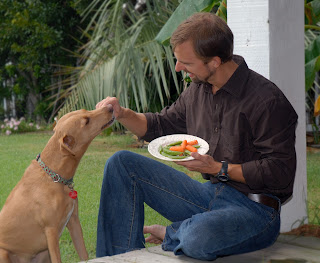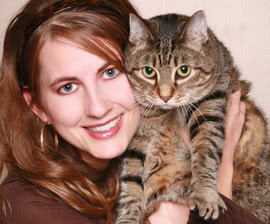 |
| Favorite House Pets to Keep If You Have Allergies |
Lizards
Firstly, you need to choose whether or not to get a herbivore or a carnivore. For the carnivorous types you will need to get live bait for food. With lizards this so that they can see it move, and identify it as food. It's not always best just to get fly larvae as if they aren't eaten immediately, they will spin cocoons and become flies, proving difficult for the lizards to catch. So it's best to stick with crickets as they will breed in the lizard's container. If you are brave enough, some larger lizards will eat live mice.
Don't give your lizard raw meat unless you physically feed them yourself, it doesn't move so they will not eat it. Most lizards do not eat every day either, so try not to overfeed, as it can cause problems including insect infestation. Always research how big your lizard will grow when adult, some get extremely big and you will have to accommodate them. Most lizards are small enough to be housed in a five or ten gallon aquarium. Always keep the lid on so the food doesn't escape! You don't want them moving into your house! Inside the tank, you must keep a heat rock; lizards are cold blooded, so it is important that they have a source of heat. You must also remember that lizards are usually sluggish creatures, so do not be overly concerned if they don't move a lot.
If you are new to lizards, begin with species that are easier to care for. These include:
Leopard Geckos which are small, easy to handle, only need a small tank, and do not need special UV lighting
Crested geckos and fat tailed geckos are very similar in their needs, so are good choices too
Bearded Dragons are docile and easy to handle, but they do need a largish tank and UV lighting
Blue Tongued Skinks are usually docile, but again need a large tank and UV lighting
Green Anoles are relatively small, they don't need a huge tank, but do need UV lighting Other lizards such as Geckos, Iguanas, Chameleons, Chinese Water Dragons and Savannah Monitors, are better suited to more experienced reptile owners. They require proper environments and large spaces.
Snakes
Can make great
house pets, but it is best never to keep large constricting snakes or venomous snakes. Most snakes will live to be about 20 years old, so they are a huge commitment. If you are starting out with snakes, try to get a snake from infancy as they will be easier to tame, so stay away from wild caught adults.
Snakes are best kept in glass or Plexiglas tank, so that you can see them and control their environment accordingly with the temperature and humidity. Always keep the lid secure. Any snake will try to escape! Try to line the enclosure with butchers' paper for easy cleaning. Don't use gravel or cat litter or wood shavings, as they trap moisture and waste and can hide parasites. They should be kept around 80 to 85 degrees during the day for tropical snakes. If necessary, have a heating pad or shielded heat lamps. Most other snakes can manage in 70 to 80 degrees.
Snakes need either live or dead food. You can buy frozen rats which you can thaw to room temperature and these are very convenient, as long as you are happy to keep them in your freezer! when it comes to feeding live ones, you must remember to train your snake to feed in this way, as a healthy rat is quite capable of seriously injuring even a large snake.
The best snakes for beginners are Corn Snakes, King and Milk Snakes and Ball Pythons. Try to avoid large constricting snakes, venomous snakes, and snakes that require more care requirements, such as Boa constrictors, red-tailed boas, Burmese pythons, Tree boas or pythons, Water snakes and Green snakes. Never have Reticulated pythons, Anacondas or any venomous snakes as these are potentially very dangerous. Another fact to bear in mind is that you may need a permit to keep certain types of snake, as they will only act on instinct and can be dangerous. Keeping exotic
house pets is a big responsibility for which you need to be prepared.
 |
| Favorite House Pets to Keep If You Have Allergies |
Spiders Tarantulas
Are the best and most popular spider to keep as a pet. However they are large and although only slightly venomous, their bite is painful. The New World spiders flick hairs from their abdomen when threatened so they can irritate the skin and eyes. However, most species are docile. You could go for a wolf spider; their venom is virtually non-existent and the bite is almost completely harmless to humans. The only problem is, is that they are fast and aggressive, and they can escape!
Tarantulas and Wolf Spiders need the same amount of space and feeding, but the temperature and humidity are different for each. Enclosures are usually fairly small, but you must ensure that you have either burrows or climbing spaces, depending on your type of spider. Hiding places are essential. Try not to use lamps, use heated strips instead. Tanks should be kept in darker areas of the room. Spiders like to feed on live insects such as crickets. Spiders tend not to overeat. However, a live prey insect may be a danger to your spider during molting.
Generally the best beginner tarantulas are the ground dwellers or burrowers, as they tend to be a little slower moving. Best tarantulas to start with include, Chilean Rose, Costa Rican Zebra, Mexican Redknee, Mexican Redleg, Desert/Mexican Blonde, and Curly Hair Tarantula. The pinktoe is a good first arboreal (tree-living) tarantula, but not a good first tarantula. Normally, arboreal species are more challenging. The pinktoe is also quite fast and agile. Try to have a female as they live longer than the males. The males will also try to get out to find a mate, causing them unnecessary distress.
Tortoises and Turtles
Can live for about 50 years and sometimes more, so they are a long term commitment. All turtles and tortoises need exposure to ultraviolet light, either by the use of UVA/UVB producing bulbs or through natural exposure to sunlight. On the whole turtles grow quite large and need large tanks. Box turtles and tortoises are best kept outdoors in pens for at least part of the year, weather permitting.
These creatures need fresh vegetables and fruits, and there are also some formulated foods on the market for certain species. Because they eat a lot, they will also produce a lot of excrement, so they can be messy. They are also not good for younger children due to the risk of salmonella. A balanced diet is essential; luckily most common garden plants, like cress, parsley and dandelion leaves are great because they have high levels of minerals and vitamins. Try to steer away from lettuce which isn't very nutritious and too much cabbage slows down a tortoises metabolism. Make sure that there is always plenty of clean water.
Ensure that you research what is best for your type of tortoise. You must consider what you can offer them in terms of space. Can you give an outdoor terrarium, indoor terrarium, or perhaps both? It is thought that tortoises are able to live outdoors and are capable of surviving our various weather conditions, but the small period of warm weather and sunshine in the UK is not really enough for farming them. Therefore tortoises should always be kept warm and awake and never put through hibernation without professional advice. Good indoor enclosures should consist of a cardboard box with a UV light and heater at one end to create a temperature gradient. Ideally though, a tank with a thermostat controlled heating and UV light will ensure a more realistic, natural environment.
Due to the kidnap of many tortoises as well as looting of turtle eggs from Southern European beaches, there is now a strict governance of only captive bred Mediterranean species being sold legitimately in the UK. Ensure that you are aware of where your tortoise or turtle has come from, as there is sadly a huge black market whereby they are smuggled into the UK from not only Europe, but Africa, Asia and South America too. Many turtles and tortoises end up at animal sanctuaries having been seized by immigration officials, so check at your local santuary first before rushing into a private purchase. The main types of tortoise for sale in the UK are now:
Greek or Spur-Thighed Tortoise
This was the original tortoise; they need daytime temperatures of 25C (78F) and 18C (65F) at night. They can spend the British summer outside; they hibernate over winter; and grows a shell length around 9 inches (22.5cm). They are herbivores, so need an area to graze
Hermann's Tortoise is another very commonly kept European tortoise, very similar to the Spur-Thighed, but with a more domed and clearly marked shell and they are slightly larger
Marginated Tortoises
Not so commonly known, grow to about 12-14 inches (30-35cm). These tortoises should only be outside on the warmest and driest of days
Horsfield's Tortoise or Russian Tortoise
Is very similar to the Greek; they hibernate and are herbivores but are sensitive to humidity, so they need slightly higher temperatures and drier conditions; only hot, dry days can be spent outside.
Bell's Hinge-Back Tortoise
Is the West African species, similar in size to the Greek. Again they need higher temperatures and more humidity, they do not hibernate and are omnivores. They can go outside in really good conditions, but otherwise need a heated tank. Only experienced owners should keep these tortoises.
Hairless Cats and Dogs
Certain breeds of dog or cat which are hairless or hypoallergenic, so a known pet allergy should not be a problem in all but the most sensitive of sufferers. For dogs these breeds include, American Hairless Terrier, Chinese Crested, Peruvian Inca Orchid and Xoloitzcuintli. Low-dander breeds which allergy sufferers may be tolerant of include Basenji, Bedlington Terrier, Bichon Frise, Irish Water Spaniel, Italian Greyhound, Kerry Blue Terrier, Maltese, Poodles, Portuguese Water Dog, Schnauzers and Soft Coated Wheaten Terrier. For cats, breeds include the Siberian, Sphynx, Cornish Rex and Devon Rex.
Whatever your choice of animal, there are certain responsibilities which come with being a pet owner. These include providing the basics of food, water and shelter, as well as health and veterinary care. Vet's fees can be expensive, so another consideration, especially for cats and dogs, should be protecting yourself financially with a good pet insurance policy. All
house pets, even spiders and reptiles, deserve love, care and attention - whether or not they are capable of showing it in return!





























